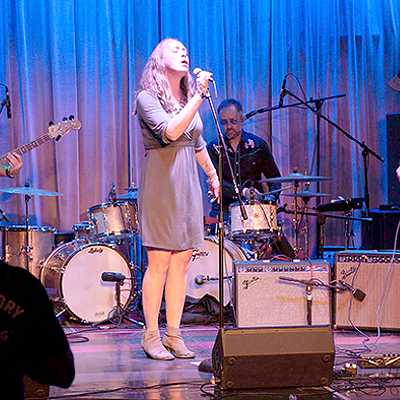Outsiders within a specialized and highly codified performing art, the Pilobolus dancers nevertheless quickly won over audiences with dynamic, acrobatic performances the likes of which hadn't been seen before in modern dance.
Today, Pilobolus Dance Theater is one of the most respected and active modern-dance companies--part of the establishment, one might argue. Although no longer young mavericks, the company's directors continue to challenge modern-dance conventions with their unique approach to making dances.
"We're an old maverick company now," chuckles Michael Tracy, one of four current artistic directors of Pilobolus, on the phone from his Connecticut office.
Tracy has been with the company since 1973. The other directors these days are Robby Barnett, Itamar Kubovy and co-founder Jonathan Wolken.
"The way we started was to put into our dances little bits of everything else that we brought to the mix, whether it was sports or gymnastics or martial arts. We all started from other fields before we found modern dance. None of us had experience creating or directing dances, and we weren't trained in Graham technique or Limón technique, for instance.
"That definitely made us different-looking from the aisles. Try as we might, we have never been able to approximate the look and feel of a traditional dance company, and I think that's one of the reasons people like us."
Although the company is more accepted in the world of modern dance now than when it began, Tracy has no idea whether Pilobolus has moved from outsider to insider status.
"We are just engaged, as we always have been engaged, in the creation of good works. For whatever reasons, we have managed to be successful at it and have an audience. We're not trying to make dances any differently in 2009 than the founders were in 1971."
One might wonder if Pilobolus has become so established that dancers and audiences now look to it as a purveyor of its own style. Tracy says that has never been a goal, but it has sort of happened anyway.
"Not purposely. Again, our mission has not been to make a technique or develop a vocabulary of movement that becomes established and easily identifiable as Pilobolus. But it has become obvious there is a clear method behind what we do."
These days, instead of being athletes and gymnasts trying out modern dance, Pilobolus dancers usually have been trained in traditional ballet and modern styles before they come to the company--so it takes a while for them to become adept at what Pilobolus does. It takes a dancer two years, on average, to adjust, Tracy says.
"That's about how long it takes to translate what they have learned through whatever technique classes they have had to a new way of doing things, the unique system in Pilobolus."
Based in Washington Depot, Conn., Pilobolus operates three primary entities: Pilobolus Dance Theater, which is the umbrella for performances; the Pilobolus Institute, which offers educational programming to schools, colleges, public-arts organizations and even corporations; and Pilobolus Creative Services, a division that produces movement for film, advertising, publishing and commercial clients.
Tracy says the success of Pilobolus has depended on the interaction and synergy among the three arms.
Not only does the dance company tour the globe incessantly, but Pilobolus pieces are in the repertoires of many major dance groups, include the Joffrey and Feld ballet companies. The company also boasts numerous credits in broadcast media, including appearances in 2004 on 60 Minutes and in 2007 on the Academy Awards.
"Being at the Oscars led to us appearing on Oprah and Conan O'Brien," Tracy says.
Pilobolus' presence in advertising and the business world also has helped the company stay strong. The company has been seen in TV commercials for Mobil, Ford, Toyota, Opel, Hyundai and others, and it has mounted special performances for such companies as IBM, Dupont Merck, Marithe Girbaud and MAC Cosmetics.
Still, Pilobolus remains true to the spirit of open, creative expression with which the company was founded, Tracy says.
"There's a social-historical aspect that is very important in modern dance and ballet--these forms are affected by the cultures in which they were created and thrived, and continue to thrive in.
"We (in Pilobolus) grew up in the 1960s; we came of age and consciousness then, and that was reflected in the way this company came into being. We formed in the chaos and revolution of that time, informed by social upheaval and changes in the arts and thinking, and the personal histories of the founders reflected the history of that period."
A '60s spirit still permeates the work of Pilobolus, Tracy says, whether a dance is an abstract illustration of cellular mitosis or an interpretation of the work of Maurice Sendak or James Joyce. But he is amused how some audience members, and company members, don't feel the generational connection to the '60s that he and the other Pilobolus directors do.
"We are older now than the parents of some of our dancers, who don't have any clue about that particular period. They see it as historical, in much the same way that we would see, say, the Civil War."
There lurks one of the most important challenges for Pilobolus--staying relevant to all audiences, Tracy says.
"One of the things about getting older is that you are now playing to multiple generations. We hope to keep them all engaged."










